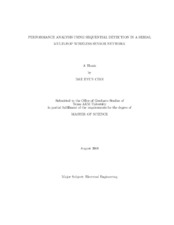| dc.description.abstract | Wireless sensor networks (WSNs) have been developed for a variety of appli-
cations such as battle�eld surveillance, environment monitoring, health care and so
on. For such applications, the design of WSN has been limited by two main resource
constraints, power and delay. Therefore, since wireless sensors with a small battery
are subject to strict power constraints, the e�cient usage of power is one of the im-
portant challenges. As delay-sensitive applications are emerging, they have been in
demand for making a quick decision with the enhanced detection accuracy. Under
above constraints, we propose a sequential detection scheme and compare it with a
Fixed-sample-size (FSS) detection scheme in terms of power and delay. Our main
contribution is to analyze the overall system performance of the proposed scheme in
the statistical signal processing framework under of power and delay constraints.
In this thesis, we evaluate the overall system performance of sequential detection
scheme in a serial multi-hop WSN topology. For sequential detection, the sensor nodes
continue to relay the observations to the next node until the sequential detector makes
a �nal decision based on the observations. On the other hand, the FSS detector waits
until all the observations come to the fusion center, and then gives a �nal decision. For
a fair comparison of the two schemes with respect to power and delay, the initial step
is to �nd the same detection performance region between the two schemes. Detection
performance is evaluated with performance measures such as false alarm, miss and
prior probability. Simulation results show that each scheme has an advantage and a disadvantage concerning power and delay respectively. That is, sequential detection
performs more e�ciently in delay since the number of samples in sequential detection
is less on average than in FSS detection to obtain the same detection performance.
However, FSS detection with a small number of packet paths consumes less power
than sequential detection. Through the analysis of a cost function, which is a linear
combination of power and delay, we compare the cost value between the two schemes
and �nd less region of the cost value in both schemes. This analysis will provide a
good starting point and foundation for designing an e�cient multi-hop WSN with
small power and delay constraints. | en |


